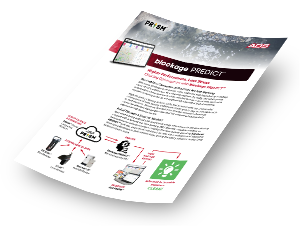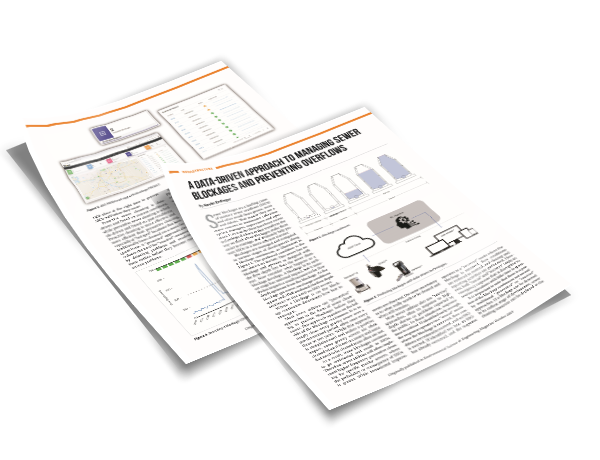
ADS has developed blockage PREDICT™ to detect the earliest signs of blockages – allowing sewer cleaning resources to be deployed at the right place at the right time in a proactive manner.
Blockage PREDICT™ is an app within PRISM™ that is specifically designed to detect the earliest signs of blockages, predict overflows, and tell you how much time you have to act. Blockage PREDICT analyzes monitor locations daily and applies a combination of machine learning(ML) algorithms and ADS expertise to show you the level status and recommend a response time-frame. You’ll have all the information you need to deploy sewer cleaning resources proactively and prevent overflows long before problems occur.
Blockage PREDICT will help you balance your teams, scheduling, and expenses with ease. By using blockage PREDICT, you can spot problems before they reach emergency status, reduce the workload by removing utility hole locations from high-frequency cleaning rotations, and keep unexpected costs down. You’ll be able to make more time for planned infrastructure projects and invest in resources that make it easier for your team to work efficiently.
Conventional schedule-driven cleaning based on historical records does reduce build-up that leads to SSOs, but this method promotes over-cleaning leading to the wasteful consumption of maintenance resources. Rather than following a demanding cleaning schedule, let blockage PREDICT tell you when and where to schedule a cleaning crew. The machine learning algorithm analyzes every monitor location daily and assigns a response urgency “status” for your review. You’ll only be cleaning when needed leading to as much as an 80% reduction in cleaning. Fewer cleanings reduce the exposure of pipes to abrasive cleaning practices that degrade their structure and reduce their asset life.
Reduce risk to your personnel and vehicles by decreasing unnecessary exposure to high traffic locations. Additionally, public satisfaction will increase with fewer traffic disruptions.
Scheduled cleaning based on blockage history leaves you open to unexpected problems. No continuous monitoring means that you are blind to what is happening in your collection system between cleanings and an overflow could occur outside of the traditional recorded overflow pattern. ADS has a solution for that. See what is happening in your collection system in real-time with ADS continuous monitoring. From there, blockage PREDICT analyzes monitor locations daily so you know when a blockage begins forming. You’ll have all the information you need to act well in advance of an overflow.
How does blockage PREDICT work?
An ADS ECHO level monitor is installed upstream from a location of interest, measuring sewer flow depth at regular time intervals. This data is transmitted periodically to the Cloud where a machine learning (ML) algorithm evaluates the data – looking for tell-tale signs of developing blockages. The results are available in the PRISM™ online software in an intuitive, easy-to-use format. Blockage PREDICT predicts developing blockages with enough notice to plan a proactive response with the right resources at the right time to prevent an overflow before it occurs.
Blockage PREDICT combines many elements to deliver a simple answer. Where will a blockage form? An ADS ECHO level monitor is installed upstream from a location of interest, measuring sewer flow depth at regular time intervals. This data is transmitted periodically to the Cloud, where a machine learning (ML) algorithm evaluates the data – looking for tell-tale signs of developing blockages. You can access the results in the PRISM™ online platform from any device. Blockage PREDICT predicts developing blockages with enough notice to plan a proactive response with the right resources at the right time to prevent an overflow before it occurs.
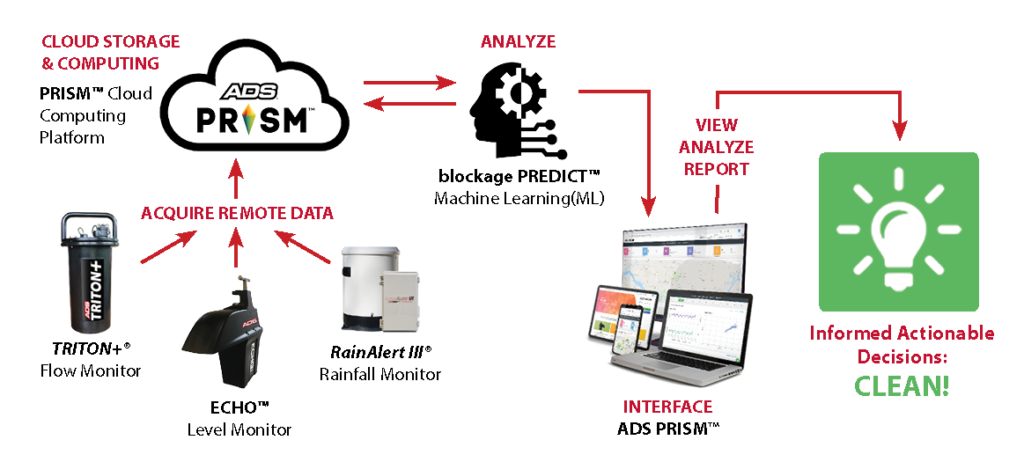
Basic Components of blockage PREDICT
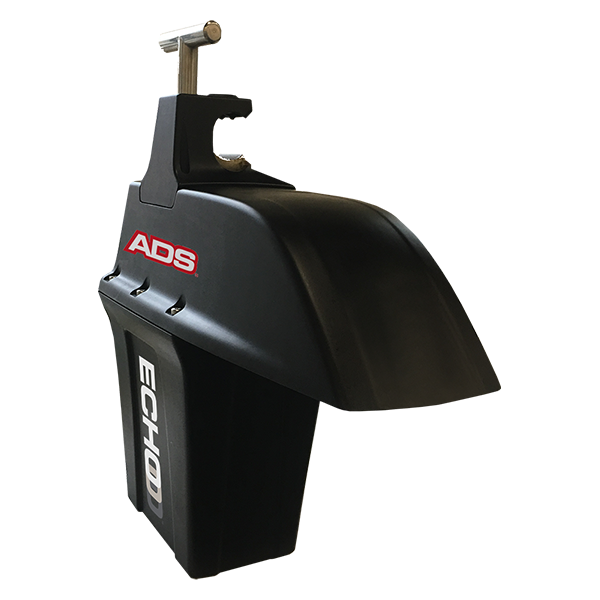 The ADS ECHO is installed near the top of a manhole where it takes continuous sewer water level measurements up 20 feet below the monitor and 8 feet above.
The ADS ECHO is installed near the top of a manhole where it takes continuous sewer water level measurements up 20 feet below the monitor and 8 feet above.
MORE INFORMATION ON ECHO //
STOREFRONT
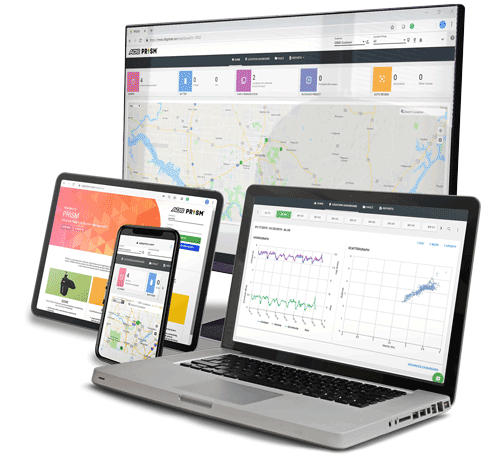
ADS PRISM is the cloud-based platform through which you can access the blockage PREDICT app. PRISM stores and analyzes all your data in one place, making it easy to access data on your schedule from any device or location with access to the web.
MORE INFORMATION ON PRISM //
STOREFRONT
Blockage PREDICT makes it easy to check your site status
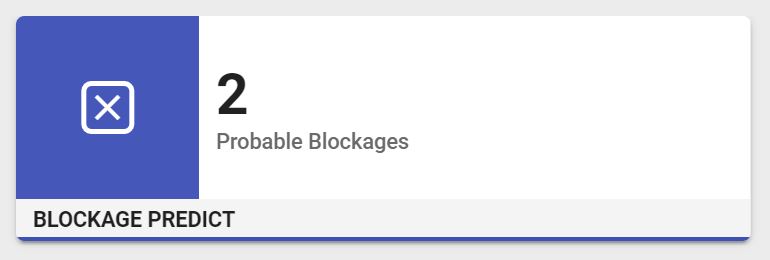
The blockage PREDICT tile displays the number of probable blockages. The widget provides a quick status of every monitor.
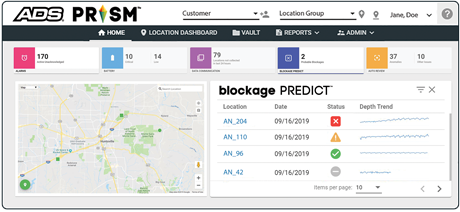
The blockage status of each location is conveyed by one of four simple icons:
GREEN “✔”: A blockage is not detected based on the ML algorithm. There is no urgency, and no action is needed. You can breathe easy.
YELLOW “!”: A blockage is probable based on the ML algorithm and is in an early stage of development before the sewer has surcharged. The response urgency level is proactive, and you may have a few days to a week or more to intervene and prevent an SSO.
RED “X”: A blockage is probable based on the ML algorithm and is in a more advanced stage of development after the sewer has surcharged. The response urgency level is reactive, and you may have a few days or less to intervene and prevent an SSO.
GRAY ” – “: Analysis did not run on this site. The ML algorithm has not yet run or does not have any data to evaluate for this date.
If this continues, you may want to check the connection or condition of your monitor.
Case Studies
blockage PREDICT Optimizes Cleaning
A developing blockage was identified by blockage PREDICT and tracked over a 12-day period (note green turning to yellow on upper the bar). blockage PREDICT identified the initial level change anomaly and tracked the overall 1-inch change in this 15” pipe. Advanced detection meant that the utility simply scheduled a field crew to investigate the site.
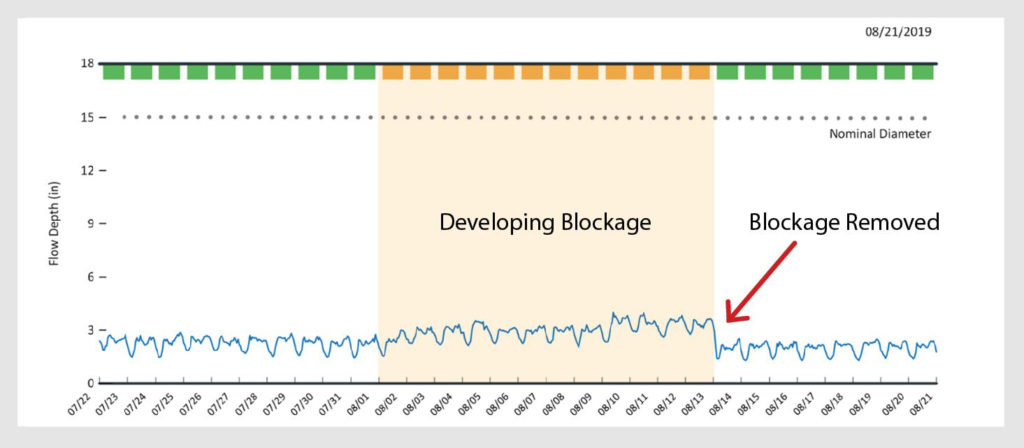
What did they find? A stick was discovered lodged and collecting debris at the outgoing sewer pipe. Once removed, flow conditions returned to normal as evidenced on the hydrograph. This utility appreciated the value of blockage PREDICT’s ability to identify a developing issue and avoid a more severe outcome.

A Data-Driven Approach To Managing Sewer Blockages and Preventing Overflows
Blockage PREDICT enables collection system managers, supervisors, and operators to take a data-driven approach to detect blockages early and deploy cleaning resources at the right place at the right time to prevent SSOs.

